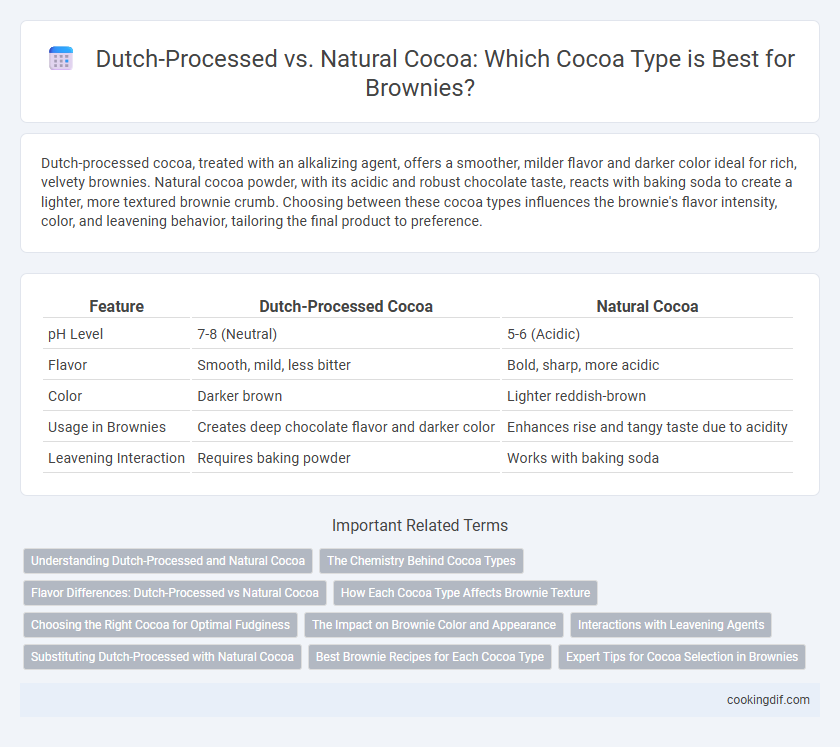Dutch-processed cocoa, treated with an alkalizing agent, offers a smoother, milder flavor and darker color ideal for rich, velvety brownies. Natural cocoa powder, with its acidic and robust chocolate taste, reacts with baking soda to create a lighter, more textured brownie crumb. Choosing between these cocoa types influences the brownie's flavor intensity, color, and leavening behavior, tailoring the final product to preference.
Table of Comparison
| Feature | Dutch-Processed Cocoa | Natural Cocoa |
|---|---|---|
| pH Level | 7-8 (Neutral) | 5-6 (Acidic) |
| Flavor | Smooth, mild, less bitter | Bold, sharp, more acidic |
| Color | Darker brown | Lighter reddish-brown |
| Usage in Brownies | Creates deep chocolate flavor and darker color | Enhances rise and tangy taste due to acidity |
| Leavening Interaction | Requires baking powder | Works with baking soda |
Understanding Dutch-Processed and Natural Cocoa
Dutch-Processed cocoa undergoes an alkalization process that neutralizes its acidity, resulting in a darker color and smoother, milder flavor ideal for rich brownies. Natural cocoa retains its original acidity, providing a sharper, more robust chocolate taste and a lighter color that reacts with baking soda to enhance leavening. Understanding these differences helps bakers choose the right cocoa to achieve the desired texture and flavor in brownies.
The Chemistry Behind Cocoa Types
Dutch-processed cocoa undergoes an alkalizing treatment that neutralizes its acidity, resulting in a smoother, milder flavor and darker color due to changes in the pH level. Natural cocoa retains its inherent acidic properties, which react more robustly with leavening agents like baking soda, leading to a distinct tang and lighter brown hue. The chemical differences between these cocoa types influence not only taste and color but also the texture and rise of brownies during baking.
Flavor Differences: Dutch-Processed vs Natural Cocoa
Dutch-processed cocoa delivers a smooth, mellow flavor with reduced acidity, creating a rich, deep chocolate taste ideal for dense, fudgy brownies. Natural cocoa offers a bright, intense chocolate aroma with sharp acidity, enhancing the classic cocoa bite and lighter texture in baked goods. Choosing between Dutch-processed and natural cocoa directly influences the brownie's flavor complexity and overall mouthfeel.
How Each Cocoa Type Affects Brownie Texture
Dutch-processed cocoa produces brownies with a smoother, more velvety texture due to its alkalized treatment that reduces acidity and enhances chocolate flavor. Natural cocoa imparts a denser and slightly crumbly texture, providing a sharper, more intense cocoa taste that reacts differently with leavening agents. Choosing between Dutch-processed and natural cocoa significantly impacts the moistness, crumb structure, and overall richness of the brownie.
Choosing the Right Cocoa for Optimal Fudginess
Dutch-processed cocoa, treated with an alkalizing agent, offers a smoother, milder flavor and darker color, making it ideal for brownies seeking a rich, fudgy texture. Natural cocoa, with its acidic profile, provides a more robust chocolate taste but can result in a lighter, cakier brownie crumb when reacting with baking soda. Selecting Dutch-processed cocoa enhances the dense, moist fudginess that defines the perfect brownie.
The Impact on Brownie Color and Appearance
Dutch-processed cocoa undergoes an alkalizing treatment that neutralizes acidity, resulting in a darker, richer color in brownies compared to the lighter, reddish hue of natural cocoa. This difference significantly impacts the visual appeal, as brownies made with Dutch-processed cocoa typically exhibit a deep, intense chocolate shade that enhances their gourmet appearance. Bakeries and home chefs often choose Dutch-processed cocoa to achieve a more visually striking and uniform brownie surface.
Interactions with Leavening Agents
Dutch-processed cocoa has a neutral pH, which limits its reaction with baking soda and requires baking powder for effective leavening in brownies. Natural cocoa, being acidic, reacts directly with baking soda to produce carbon dioxide, giving brownies a lighter texture and rise. Understanding the interaction between cocoa type and leavening agents is crucial for achieving the desired brownie consistency and flavor profile.
Substituting Dutch-Processed with Natural Cocoa
Using natural cocoa powder instead of Dutch-processed cocoa in brownies affects both taste and chemistry, as natural cocoa is more acidic and imparts a brighter, more complex chocolate flavor. When substituting, baking soda often replaces baking powder to neutralize the acidity, ensuring proper leavening and texture. This switch may result in a slightly lighter color and a more nuanced bitterness, highlighting the cocoa's natural fruity and acidic notes.
Best Brownie Recipes for Each Cocoa Type
Dutch-processed cocoa offers a smoother, milder flavor and darker color, ideal for brownies with a rich, velvety texture like classic fudgy or double chocolate recipes. Natural cocoa's bright, slightly acidic taste enhances traditional or cakey brownie recipes, balancing sweetness and producing a more pronounced chocolate flavor. Choosing the right cocoa type depends on the desired texture and flavor profile, ensuring the best results in each brownie variation.
Expert Tips for Cocoa Selection in Brownies
Dutch-processed cocoa offers a smooth, mellow flavor and darker color, ideal for fudgy brownies, while natural cocoa provides a sharper, more acidic taste that reacts well with baking soda for a lighter texture. Experts recommend selecting Dutch-processed cocoa for rich, dense brownies and natural cocoa when a deep chocolate tang with a tender crumb is desired. Proper cocoa choice enhances both flavor and texture, making the brownie baking process more precise and predictable.
Dutch-Processed vs Natural Cocoa for cocoa type Infographic

 cookingdif.com
cookingdif.com